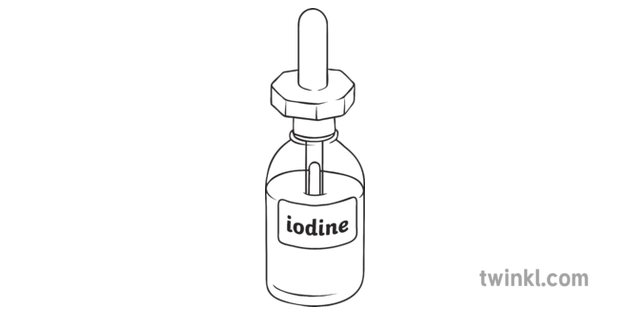Aim: To test if a sample of food contains complex sugars.
Hypothesis: I think that in the;
Glucose - won't change colour because it is a simple sugar.
Apple - won't change colour because it's also a simple sugar.
Bread - will change because it is complex sugar.
Potato - will also change colour because it is complex sugar.
Egg - it might have simple sugar or complex sugar because it's protein.
Milk - it might have simple sugar or complex sugar because it's also protein.
Equipment:
- Test Tube
- Food Sample
- Iodine Solution

Method:
- Place about 2 ml of sample in a test tube.
- Add 3-5 drops of iodine and mix.
First, we tested the bread. From my hypothesis, I had predicted that bread is complex sugar. When we had tested the bread with the iodine, it changed colour because it was complex sugar. It changed the colour to black.
Secondly, I tested the apple. What I wrote in my hypothesis, that it won't change the colour because it is a simple sugar. But, actually, it changed colour, so apple is complex sugar. It changed the colour to dark green.
Thirdly, I tested the potato. According to my hypothesis, I had written that the potato will change colour because it is complex sugar. Actually, my hypothesis was right, it had changed colour because it was complex sugar.
Next, we had tested glucose (sugar). From my hypothesis, I had written that it won't change colour because it is a simple sugar. I couldn't tell if it was or not because what I could see was iodine.
After glucose, we had tested the egg. From my hypothesis, I guessed that it might or might not change because it's protein. This test was similar to the last one, I couldn't tell because what I could see was iodine.
Lastly, we tested the milk. From my hypothesis, I had written that it might change colour or not because it's protein.
Conclusion
In conclusion, my hypothesis was 50% correct, it's okay because there are no right or wrong answers in the hypothesis. From the hypothesis, it is what I thought about this type of food.
What I had written in my hypothesis, is that glucose won't change colour, because it's a simple sugar. But, actually, I was wrong, which is good because I had learnt something new.
The next food that I had written about was an apple. I had written that it won't change colour, but it actually did.
The third food that I had tested was the bread. I had written that it will change colour because it's a complex sugar, which was correct.
The fourth food that I had tested was the potato. I had written that it will change colour because it's a complex sugar, which was correct.
The fifth food that I tested was the egg. I couldn't tell if it changed the colour or not, so I didn't know.
The last food that I tested was the milk. When iodine was added, it diluted slightly, but it didn't change colour. So, milk is not complex sugar.
What I observed that all of the food samples that we had tested were all complex sugars.
What I've learnt in this experiment is that glucose, apple and bread is complex sugar.
| Apple |
| Potato |
| Glucose (Sugar) |
| Egg |
Next, we had tested glucose (sugar). From my hypothesis, I had written that it won't change colour because it is a simple sugar. I couldn't tell if it was or not because what I could see was iodine.
After glucose, we had tested the egg. From my hypothesis, I guessed that it might or might not change because it's protein. This test was similar to the last one, I couldn't tell because what I could see was iodine.
Lastly, we tested the milk. From my hypothesis, I had written that it might change colour or not because it's protein.
Conclusion
In conclusion, my hypothesis was 50% correct, it's okay because there are no right or wrong answers in the hypothesis. From the hypothesis, it is what I thought about this type of food.
What I had written in my hypothesis, is that glucose won't change colour, because it's a simple sugar. But, actually, I was wrong, which is good because I had learnt something new.
The next food that I had written about was an apple. I had written that it won't change colour, but it actually did.
The third food that I had tested was the bread. I had written that it will change colour because it's a complex sugar, which was correct.
The fourth food that I had tested was the potato. I had written that it will change colour because it's a complex sugar, which was correct.
The fifth food that I tested was the egg. I couldn't tell if it changed the colour or not, so I didn't know.
The last food that I tested was the milk. When iodine was added, it diluted slightly, but it didn't change colour. So, milk is not complex sugar.
What I observed that all of the food samples that we had tested were all complex sugars.
What I've learnt in this experiment is that glucose, apple and bread is complex sugar.